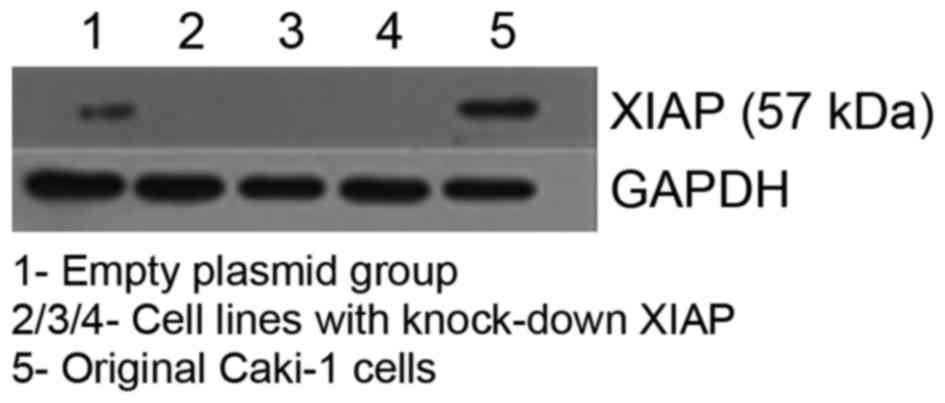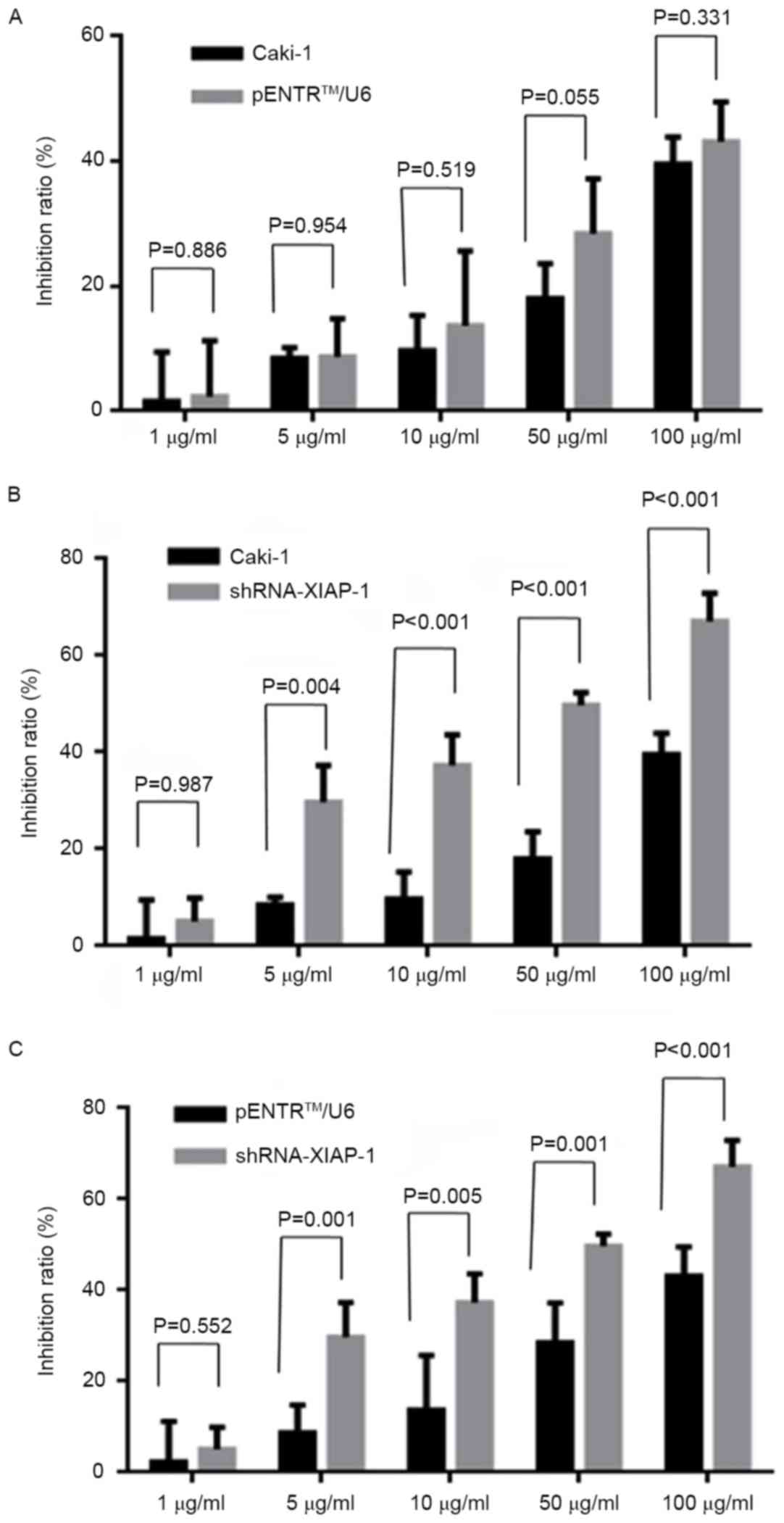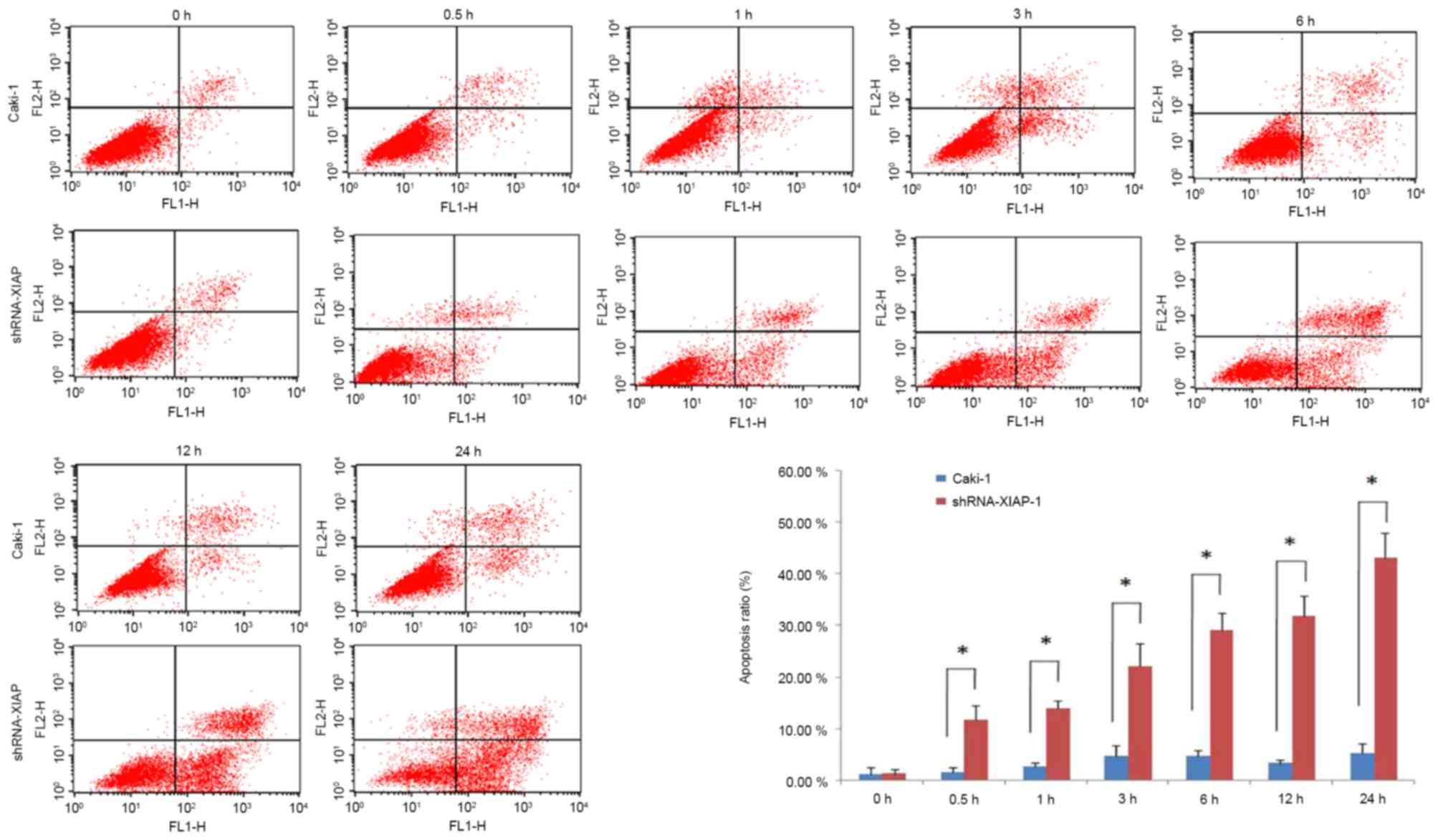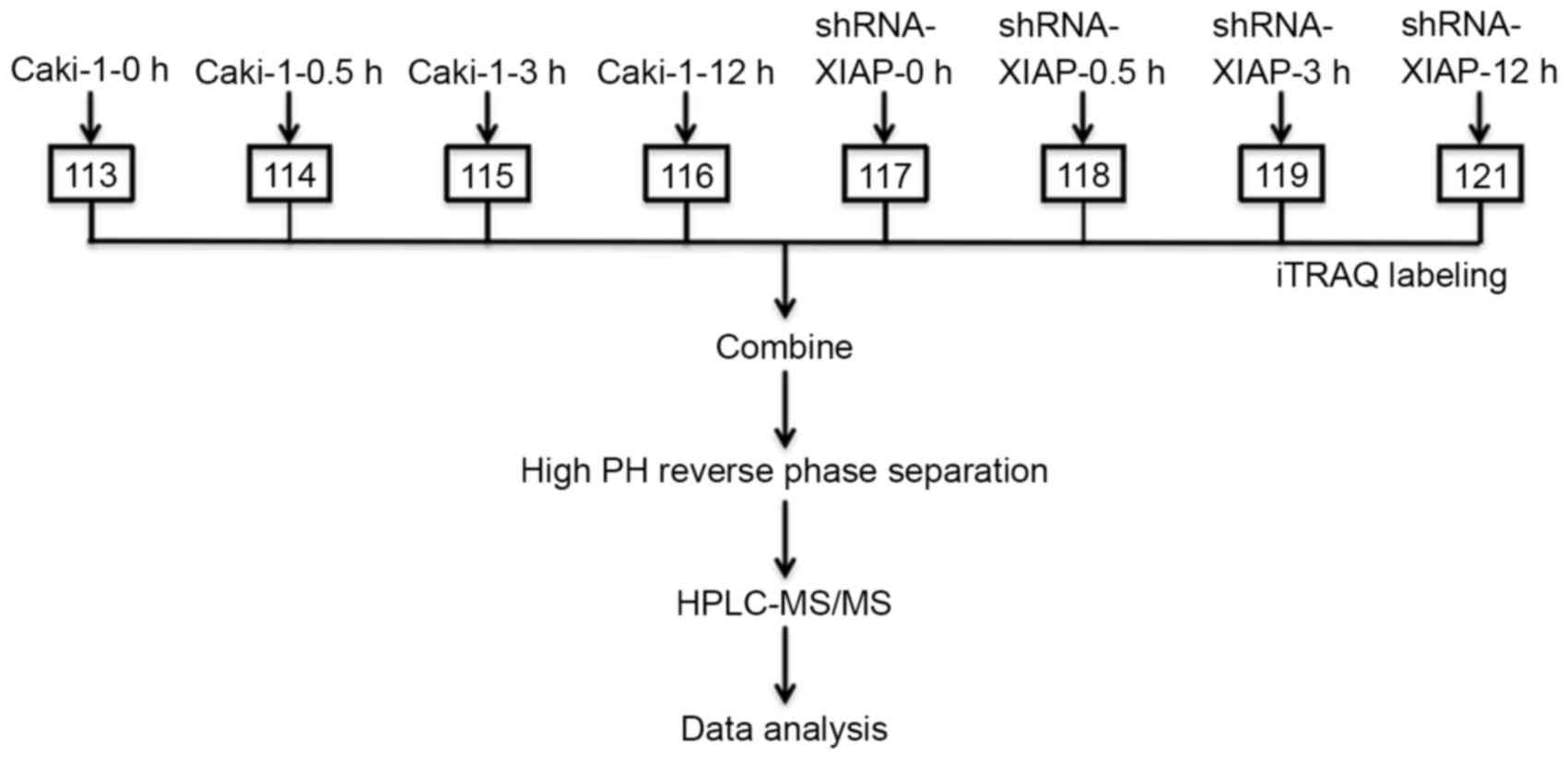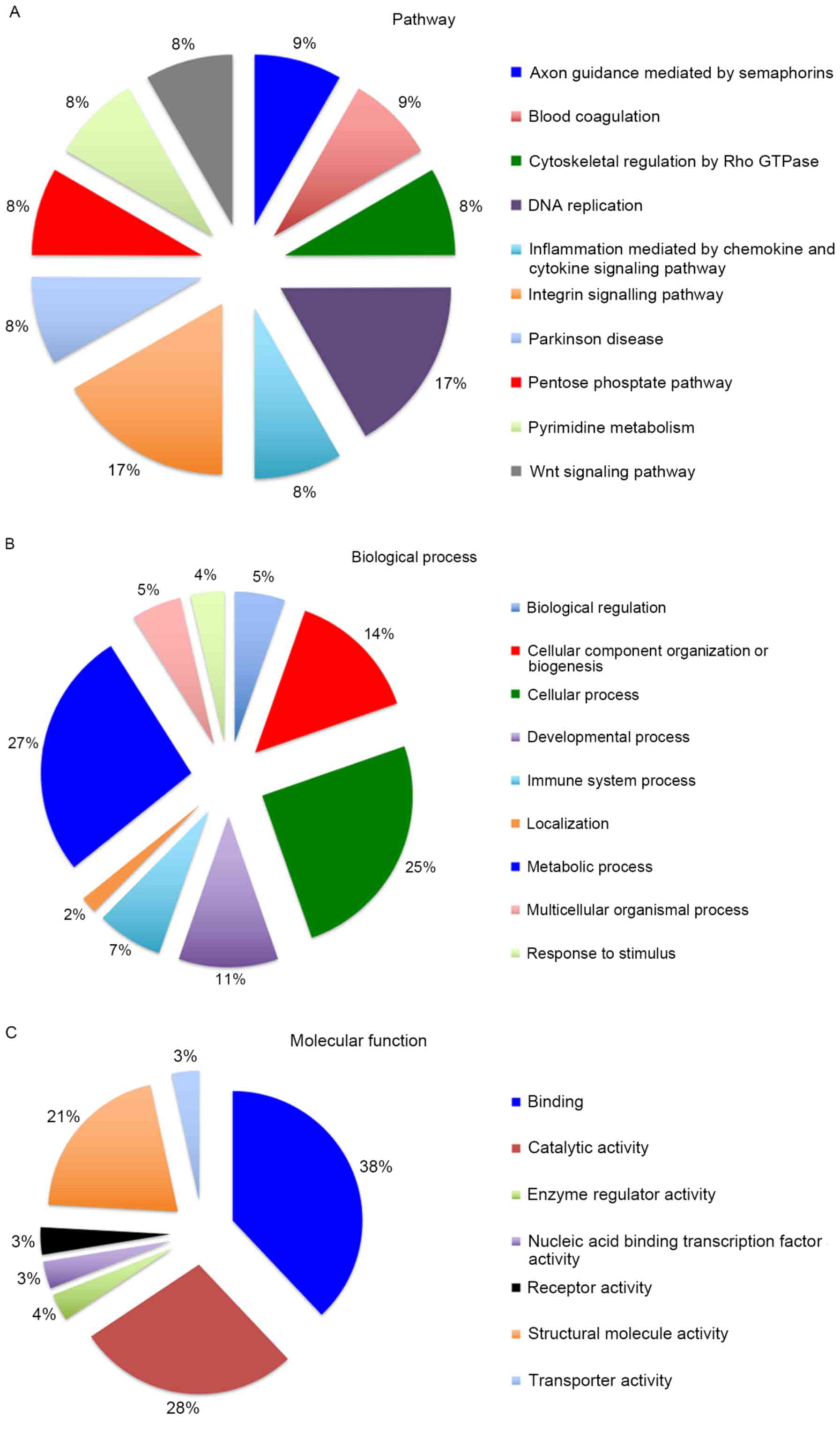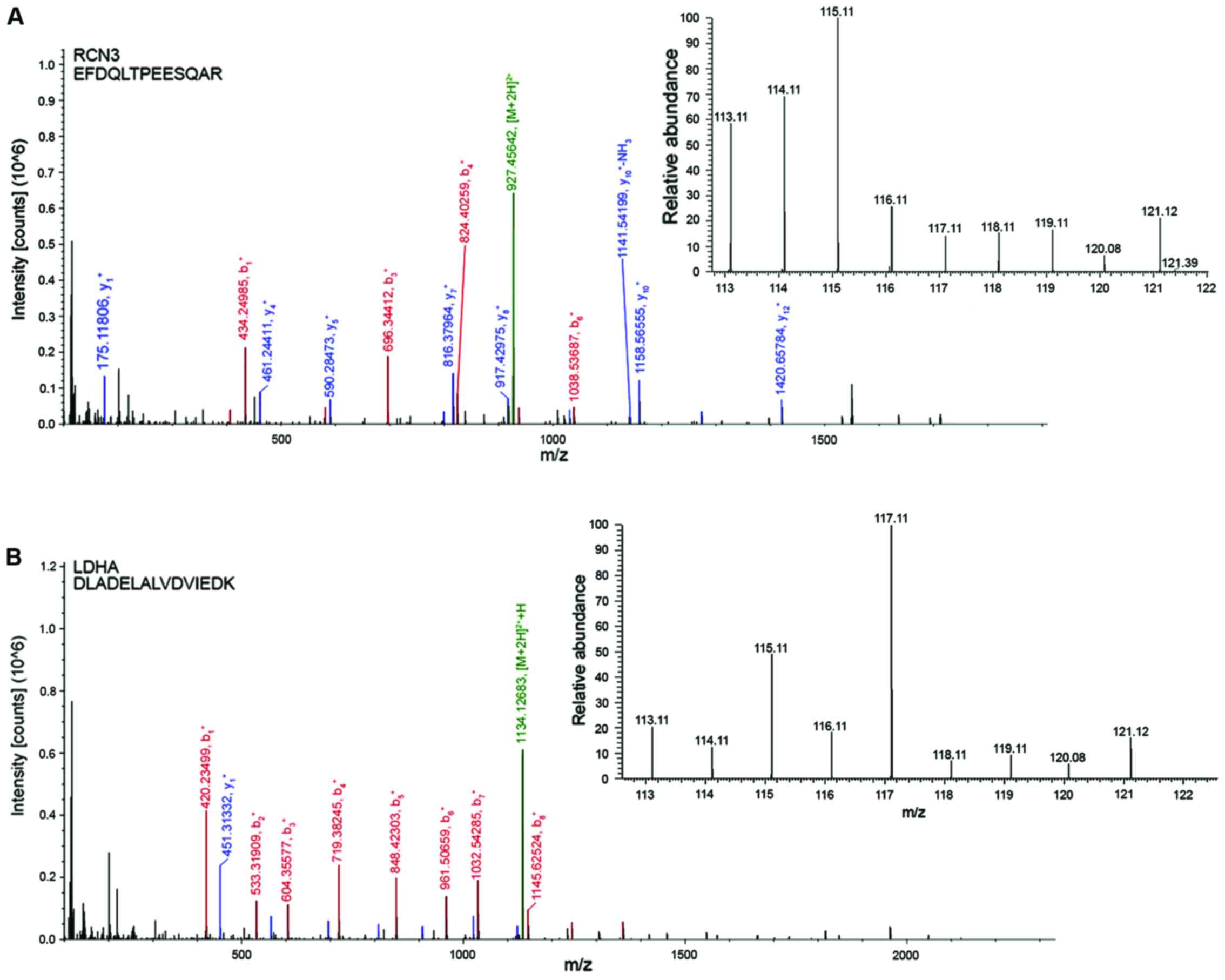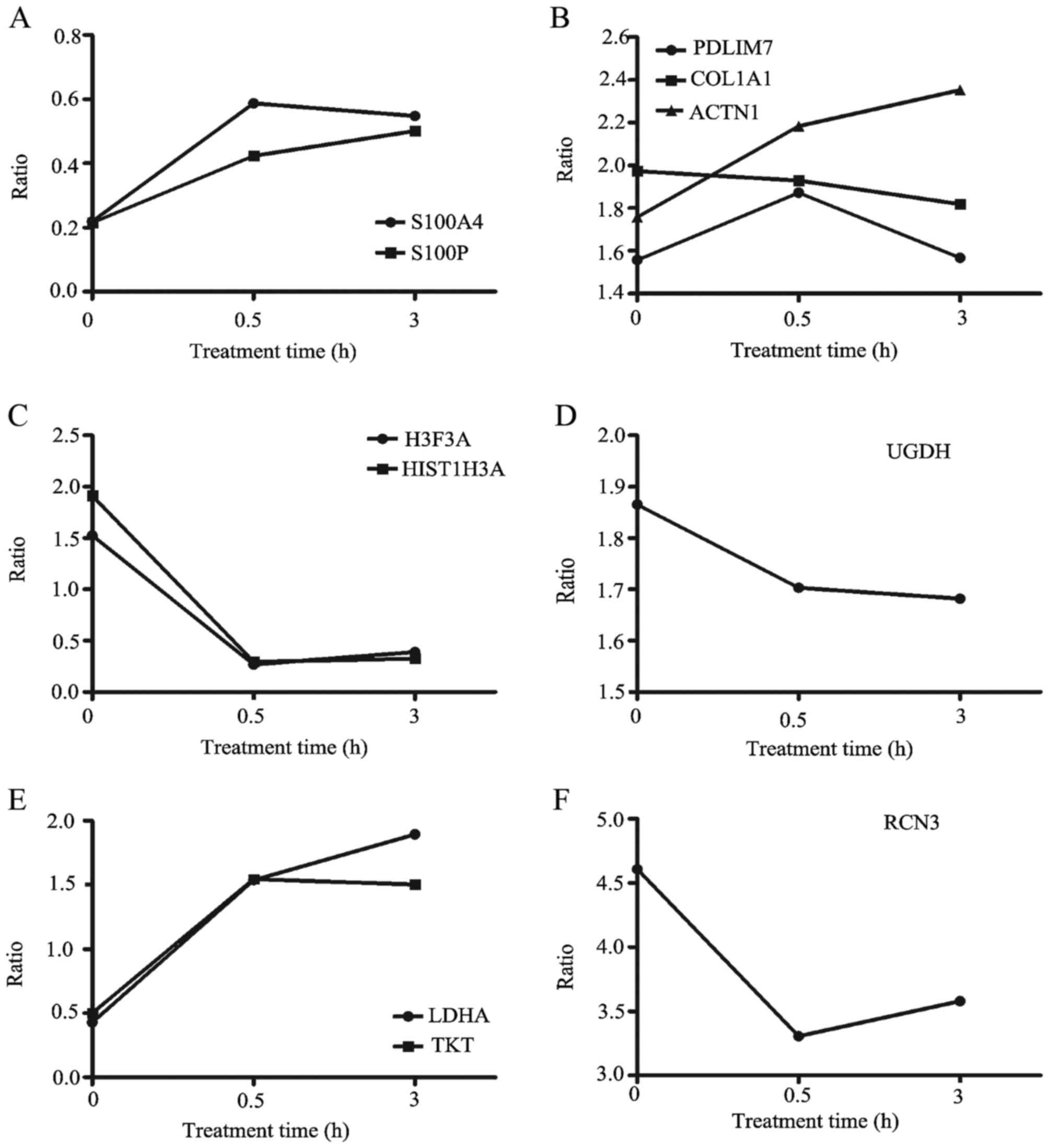Potential biological process of X‑linked inhibitor of apoptosis protein in renal cell carcinoma based upon differential protein expression analysis
- Authors:
- Published online on: November 9, 2017 https://doi.org/10.3892/ol.2017.7383
- Pages: 821-832
-
Copyright: © Chen et al. This is an open access article distributed under the terms of Creative Commons Attribution License.
Abstract
Introduction
Renal cell carcinoma (RCC), the most common type of kidney cancer, accounts for 2–3% of all malignancies in adults (1). However, RCC is highly resistant to conventional anticancer treatments, including radio- and cytotoxic chemotherapy. Previous studies have demonstrated that RCC cell lines are resistant to the apoptosis induced by chemical or immunological preparations and radiation (2). Apoptosis, the most well-known form of programmed cell death, is a controlled, energy-dependent process. Strategies to combat the resistance of tumors to apoptosis through extrinsic and intrinsic pathways are being investigated. Once the glutathione protease (caspase) family is activated, apoptosis is triggered (3). Inhibitors of apoptosis proteins (IAP) directly bind to and inhibit the caspases, serving a vital role in the regulation of cell apoptosis (4). The X-linked IAP, the most potent and ubiquitous caspase inhibitor in the IAP family, is the downstream inhibitor of apoptosis (5). XIAP is able to restrain apoptosis through suppression of the apoptosis initiation factor, caspase-9, and the implementation factors, caspase-3 and −7 (6). XIAP is highly expressed in various malignancies and is weakly expressed or absent in healthy cells (7). A previous study demonstrated that XIAP expression is markedly upregulated in RCC compared with that in healthy kidney cells (8). Additionally, in our previous study, an upregulation and a stage- and grade-dependent increase in anti-apoptotic XIAP expression in RCC were observed through analysis of XIAP expression in the primary tumor tissue of 66 RCC patients (9). Given its role in apoptosis and its frequently elevated expression in malignant cells, XIAP may be a promising therapeutic target in cancer (10). Numerous studies have demonstrated that if XIAP expression were to be inhibited by antisense oligonucleotides or small interfering RNA (siRNA), the proliferation of tumor cells may be suppressed, cell apoptosis induced and malignant cells sensitized to chemotherapeutic agents (11,12). However, a previous study on the biological functions of XIAP focused on the direct competitive inhibition of caspases by its baculoviral IAP repeat (BIR) 1, BIR2 and BIR3 domains (13). Further studies have demonstrated that the RING domain of XIAP, which has E3 ubiquitin ligase activity, is able to promote the self-ubiquitination degradation of XIAP and its negative regulatory protein, second mitochondria-derived activator of caspase/direct inhibitor of apoptosis-binding protein with low pl. As a result of the E3 ubiquitin ligase activity of its specific RING domain, XIAP is able to attach to target proteins to determine their specificity to ubiquitination by recognizing target substrates and promoting protein degradation (14). A previous study demonstrated that XIAP mediated rapid mouse double minute 2 homolog (Mdm2) degradation through intrinsic E3 ubiquitin ligase activity and regulation of the Mdm2-tumor protein p53 (p53) signaling pathway (15). A small number of reports have demonstrated that the XIAP RING domain influences certain signaling cascades associated with cell death, inflammation and cell migration (16,17). Therefore, it remains unclear whether or not XIAP also participates in the regulation of other pathways by means of ubiquitin-mediated degradation of specific substrates by its RING domain. It may be beneficial to elucidate the currently unknown biological functions of XIAP in RCC.
In the present study, the Caki-1 cell line with XIAP overexpression was selected and a stably transfected Caki-1 cell line with XIAP-knockdown was established using RNA interference technology. The general dynamic difference in proteins between the 2 cell lines was determined through proteomic analysis, using isobaric tag for relative and absolute quantitation (iTRAQ) technology, during apoptosis induced by etoposide. Through determination of the significantly differentially expressed proteins, certain features in the potential downstream regulatory proteins of XIAP were observed. These results suggest that XIAP may serve important roles in a diverse set of non-apoptotic signaling pathways in RCC and may have potential value in tumor gene therapy.
Materials and methods
Establishing Caki-1 cell lines with a deficiency in XIAP expression
Caki-1 cells were purchased from China Infrastructure of Cell Line Resources (Beijing, China). The cells were grown in minimum essential medium (Gibco; Thermo Fisher Scientific, Inc., Waltham, MA, USA) supplemented with 10% fetal bovine serum (FBS; Zhejiang Kangyuan Biological Technology Co., Ltd., Zhuji, China) and maintained at 37°C in a humidified incubator with 5% CO2. The cells were split twice weekly and cells that were in the logarithmic growth phase were used for experiments.
The XIAP interference target of the present study was based upon that in the study by Bilim et al (18), which had verified that there were no homologous sequences between this fragment and other genes, and that the short hairpin RNA (shRNA) containing this fragment effectively downregulated the expression of XIAP. The target sequence was 5′-AGGTGAAGGTGATAAAGTA-3′. The BLOCK-iT™ U6 RNAi Entry Vector kit (Invitrogen; Thermo Fisher Scientific, Inc.) was applied for construction. Based upon the selected target sequence, the oligonucleotide sequences of shRNA used were: Top strand, 5′-CACCGAGGTGAAGGTGATAAAGTACGAATACTTTATCACCTTCACC-3′, and bottom strand, 5′-AAAAGGTGAAGGTGATAAAGTATTCGTACTTTATCACCTTCACCTC-3′.
These shRNA-encoding complementary single stranded oligonucleotides were hybridized to give XhoI- and HindIII-compatible overhangs prior to being ligated into pENTR™/U6. The constructed plasmids were confirmed by sequencing and were termed XIAP-shRNA-pENTR/U6.
Transfection was performed using Lipofectamine® (250 ng/µl) 2000 transfection reagent (Gibco; Thermo Fisher Scientific, Inc.) and a BLOCK-iT U6 RNAi Entry Vector kit (Invitrogen; Thermo Fisher Scientific, Inc.). In order to generate stably transfected clones, the transfected cells were selected with Geneticin (KangWei Technology, Beijing, China) for 3–4 weeks (the successfully transfected Caki-1 cell exhibited Geneticin resistance). The stably transfected Caki-1 cell clones were cloned and collected, and were termed Caki-1/XIAP-shRNA-pENTR, with Caki-1/pENTR as the control cells. Due to the fact that the PENTR/U6 plasmid possesses the GFP gene, it is able to produce green fluorescence under a certain wavelength laser and thus, a fluorescence microscope (Thermo Fisher Scientific, Inc.) was used to identify transfected cells. Following formation of the clone cells, the monoclonal cell colony with green fluorescence was selected and transferred onto a 24-well plate for amplification.
Whole cell proteins were isolated using a radioimmunoprecipitation assay reagent (Beyotime Institute of Biotechnology, Haimen, China) and an equal mass of total protein (40 µg) from each lysate was loaded onto 10% SDS-PAGE. Following electrophoresis, separated proteins were transferred onto polyvinylidene difluoride membranes and were blocked with TBST containing 10% powdered skimmed milk for 2 h at room temperature prior to being incubated with antibodies against XIAP (cat no. PRS3331; 1:2,000) and GAPDH (cat no. G9545; 1:20,000; both Sigma-Aldrich; Merck KGaA, Darmstadt, Germany) overnight at 4°C. Next, the substrate was catalyzed to emit light, the exposure stripe was scanned, and the ratio of the grey values of XIAP and GAPDH was taken as the relative content of XIAP protein.
Cell viability was determined by MTT assay. An MTT kit (Gibco; Thermo Fisher Scientific, Inc.) was used to detect the inhibition rate of cells at varying drug concentrations (1, 5, 10, 50, 100 µg/ml). Etoposide was used as an apoptosis inducer. DMSO was used to dissolve the purple formazan, and viability was subsequently analyzed at a wavelength of 570 nm. In an additional experiment, in order to improve the experimental efficiency, flow cytometry with BD FACSDiva Software 6.0 (BD Biosciences, Franklin Lakes, NJ, USA) was used to detect early apoptosis according to the manufacturer's protocol. The percentage of apoptotic cells was detected by flow cytometry using an Annexin V/FITC and PI Apoptosis Detection kit (BD Biosciences; cat. no. 556547; Annexin V-FITC Apoptosis Detection kit). BD Cellquest Pro software (version 5.1; BD Biosciences) was used to analyze the experimental data.
iTRAQ and mass spectrometry
The Caki-1 (overexpression of XIAP) and XIAP-shRNA-pENTR/U6 (XIAP-knockdown) renal cell lines were harvested. The two cell lines were cultured with 10% FBS McCoy's 5A medium (cat no. SH30200.01; Hyclone; GE Healthcare Life Sciences, Logan, UT, USA), and the cells were digested with 0.25% trypsin (cat no. REK3011; OXOID; Thermo Fisher Scientific, Inc.). Each of the cell lines was divided into 8 T-75 cell culture bottles, each with 15 ml cell suspension. Caki-1 cells and XIAP-shRNA cells were treated with 60 µg/ml etoposide for 0.5, 3 and 12 h at 37°C. The control group was set at 0 h. Samples were ground in liquid nitrogen.
Cells were washed with phosphate-buffered saline and were collected by incubation (5% CO2 and 37°C for 1 h) with 2 ml cellular lysis buffer (8 M urea, 30 mM HEPES, 1 mM PMSF, 2 mM EDTA and 10 mM DTT). Ultrasonic processing (pulse on for 2 sec, pulse off for 3 sec; power, 180 W) of this solution was then performed using an ultrasonic processor and centrifugation at 20,000 × g for 30 min at 4°C. The supernatant was transferred to a fresh tube and stored at −80°C until use. For each sample, proteins were precipitated with ice-cold acetone prior to being redissolved in dissolution buffer (50% TEAB and 0.1% SDS). The proteins were quantified by the Bradford protein assay (Promega Corporation, Madison, WI, USA). Subsequently, 100 mg protein was tryptically digested and the resultant peptide mixture was labeled using the iTRAQ reagent (Applied Biosystems; Thermo Fisher Scientific, Inc.). The protein solution was further digested with sequence-grade modified trypsin. For labeling, each iTRAQ reagent was dissolved in 70 µl isopropanol and added to the respective peptide mixture. Protein samples were labeled with iTRAQ isobaric tags: 113, 114, 115, 116, 117, 118, 119 and 121.
To reduce sample complexity during liquid chromatography tandem mass spectrometry (LC-MS/MS) analysis (Strong cation exchange chromatography; SCX), the iTRAQ labeled peptide samples were reconstituted in Buffer A (25% ACN, 10 mM KH2PO4; pH 3.0) and fractionated using Ultremex SCX column (Phenomenex, Torrance, CA, USA; Luna SCX 100A) via the LC-20AB HPLC Pump system (Shimadzu Corporation, Kyoto, Japan) at a flow rate of 1.0 ml/min with a gradient of Buffer B (25% ACN, 2 M KCL, 10 mM KH2PO4; pH 3.0). Buffer B reached 100% in 10 min. The column flow rate was maintained at 400 nl/min, and the column temperature was maintained at room temperature and at a pressure of 1,000 psi. The collected fractions were desalted using Strata X C18 column (Phenomenex), and were vacuum centrifuged (4°C and 20,000 × g for 30 min) and reconstituted in 0.1% formic acid for subsequent LC-MS/MS analysis. The mass spectroscopy (MS) analysis was performed using a Q Exactive™ Hybrid Quadrupole-Orbitrap™ Mass Spectrometer (Thermo Fisher Scientific, Inc.). Nanoflow electrospray ionization MS/MS analysis of peptide samples was performed using an Eksigent NanoLC-2D system (AB SCIEX, Framingham, MA, USA).
MS and MS/MS data searches were performed using the Proteome Discoverer 1.3 (PD; Thermo Fisher Scientific, Inc.) based upon the workflow with a spectrum selector and reporterion quantifier. The proteins were identified and quantified using the Mascot search engine (version 2.3.0; Matrix Science Inc., Boston, MA, USA). To minimize false positive results, a strict cutoff for protein identification was applied with an Unused Prot Score ≥1.3, which corresponds to a confidence limit of 95%, and two peptides with 95% confidence were considered for protein quantification.
The functional annotations were obtained from the Gene Ontology database (http://www.geneontology.org/). The metabolic pathways associated with the differentially expressed proteins were classified using the Kyoto Encyclopedia of Genes and Genomes (KEGG) (19).
Statistical analysis
Using SPSS 17.0 (SPSS, Inc., Chicago, IL, USA) statistical software for analysis, the difference between two groups was compared using Student's t-test, and the difference among more than two groups was compared using a one-tailed analysis of variance followed by Duncan's multiple-range test. P<0.05 was considered to indicate a statistically significant difference.
Results
RNA interference effectively decreases XIAP expression
In order to decrease the expression of XIAP in Caki-1 cells, sequence-specific siRNA of XIAP was synthesized in the aforementioned manner. In order to generate stably transfected clones, the transfected cells were selected for 3–4 weeks. Three of the stably transfected cell clones were screened out and one was selected for further experiments. The interference efficiency of XIAP-knockdown cells was confirmed by western blot analysis. As demonstrated in Fig. 1, XIAP shRNA transfection markedly reduced the expression of XIAP, while no significant difference was observed between XIAP expression in the Caki-1 control group and that in the pENTR/U6 group.
Stably transfected XIAP-knockdown Caki-1 cell line is more sensitive to apoptosis induction than the original Caki-1 cell line
To further evaluate whether XIAP-knockdown would influence the anti-apoptotic ability of Caki-1 cells, the MTT method was used to detect the cell death rate under different drug concentrations (1, 5, 10, 50 and 100 µg/ml) and flow cytometry was used to detect the apoptosis rate at 0, 0.5, 1, 3, 6, 12 and 24 h. As demonstrated in Fig. 2, following XIAP-knockdown, the cell death rate was significantly increased under all drug concentrations ≥5 µg/ml, while there was no statistically significant difference in the cell death rate between the original Caki-1 group and the pENTR/U6 group. Additionally, the inhibition ratio of the 50 µg/ml treatment group was significantly greater compared with that of the 0 µg/ml group between shRNA and Caki-1 cell lines. The results of the flow cytometry further demonstrated that the occurrence of apoptosis in the cell line with XIAP-knockdown was significantly higher than that in the original Caki-1 cell line (Fig. 3).
Number of differentially expressed proteins determined by iTRAQ profiling
To investigate the effect of XIAP on apoptosis, iTRAQ-based quantitative proteomics were performed on Caki-1 cells and XIAP-knockdown cells treated with etoposide for 0, 0.5, 3 and 12 h (Fig. 4).
A total of 1,783 proteins were identified and quantified by the iTRAQ technique. Statistical calculations for iTRAQ-based detection and relative quantification were then performed using PD software. The protein identification threshold, an Unused Prot Score of >1.3, was used to obtain a confidence level of 95%. The differentially expressed proteins were defined as the relative ratio of >1.5 or <0.5 (calculated as a ratio of Caki-1 cells/XIAP-knockdown cells; P<0.05). Based upon these criteria, 87 proteins were significantly altered at 0 h. Following apoptosis induction, there were 178 significantly altered proteins at 0.5 h and 169 proteins at 3 h. However, no difference was observed in the level of protein expression between the two cell lines at 12 h, indicating that the change in cell protein levels mainly occurs in the early stages of apoptosis.
Differentially expressed proteins are implicated in a number of pathways and biological processes
In order to further understand the role of XIAP in cell death and to screen for currently unknown biological behaviors of XIAP, the differentially expressed proteins were dynamically analyzed at 0, 0.5, 3 and 12 h. At the 12-h stage of apoptosis, no differential proteins were observed (under the conditions of a ratio >1.5 or <0.5; P<0.05). Therefore, the focus was on the early stage of apoptosis between 0 and 3 h. As demonstrated in Table I, the ratio (Caki-1/shRNA-XIAP-1) of 22 proteins was significantly altered at 0, 0.5 and 3 h in response to etoposide treatment. Subsequently, 22 differentially expressed proteins associated with XIAP were classified using the Protein Analysis through Evolutionary Relationships classification system (www.pantherdb.org) to obtain a better understanding of their molecular and functional characteristics. The results revealed the distribution of differentially expressed proteins in pathways, biological processes and molecular functions (Fig. 5). These results indicate that the differentially expressed proteins are involved in a number of pathways and biological processes, suggesting that XIAP has a number of potential physiological functions. The relevant literature and the existing data were then combined to screen out the biological behaviors associated with the onset and progression of cancer. In general, differentially expressed proteins were implicated in the p53 pathway, cytoskeletal regulation, histone regulation, the Wnt signaling pathway, glucose metabolism and endoplasmic reticulum (ER) stress. Representative MS/MS spectra of select peptides with their reporter ions are presented as the 6 proteins, reticulocalbin 3 (RCN3), lactate dehydrogenase A, UDP-glucose 6-dehydrogenase (UGDH), histone H3.3, S100 calcium-binding protein A4 (S100A4) and collagen, type 1, α-1 (COL1A1) (Fig. 6).
p53 pathway
As demonstrated in Table I, S100A4 and S100 calcium-binding protein P (S100P) were downregulated in the Caki-1 cells. The S100 protein family belongs to the calcium-binding protein family, members of which have a similar structure, but a different function. S100A4 may be combined with the regulatory region of the p53 protein C terminal, and through protein kinase C, may inhibit the phosphorylation reaction of the full-length p53 protein (20). S100A4 may also promote tumor invasion and metastasis (21). The results of the present study also demonstrated that there was a significant change (P=0.002) in the members of the S100 family following apoptotic stimulation (Fig. 7A), which indicates that XIAP may affect the p53 signaling pathway by regulating associated S100 family proteins.
Cytoskeletal regulation
Overall, 3 proteins involved in cytoskeletal organization were upregulated in Caki-1 cells and the relative ratios were all >1.5 at the three time points (Fig. 7B). Among them, α-actinin-1 (ACTN1) cross-linked with the actin cytoskeleton, through cadherin, integrins, vinculin, catenin or talin, and mediated the adhesion of adjacent cells or the adhesion of cells to the extracellular matrix (22). In addition, following the induction of apoptosis, the level of ACTN1 differed more markedly (Fig. 7B). Additionally, the expression of COL1A1, which can promote cell adhesion and cell proliferation, was also increased (23). The cytoskeletal PDZ-LIM protein family has a PDZ domain with a scaffolding function through which the coordinated assembly of proteins can occur. These results indicate that XIAP participates in cytoskeletal regulation through ACTN1, COL1A1 and PDLIM7.
Histone regulation
In the present study, two histone proteins were altered. Not only does histone modification regulate gene expression, but it also recruits the protein complex, affecting the downstream proteins and thereby participating in cell division, cell apoptosis and memory formation, as well as affecting the immune system and inflammatory response. The phosphorylation, acetylation, methylation and ubiquitination of histone proteins can be used as a marker of DNA injury, and recruited repair proteins serve an important role in the process of DNA repair (24,25). The present results indicated that the ratios (Caki-1/shRNA-XIAP-1) of two histone proteins were upregulated at 0 h, but were decreased at 0.5 and 3 h (Fig. 7C). These results suggest that XIAP serves an important role in histone regulation.
Wnt signaling pathway
The enzyme UGDH catalyzes the two-fold oxidation of UDP-glucose into UDP-glucuronic acid, the activated nucleotide sugar donor required for the synthesis of heparin sulfate glycosminoglycans (26). To a large extent, the biological functions of heparin sulfate proteoglycans (HSPGs) depend upon the interaction of the glycosaminoglycan chains with different protein ligands. HSPGs are present at the cell surface and in the extracellular matrix. Through their projection into the extracellular space, HSPGs are capable of interacting with signaling molecules and can ultimately influence the activity route of their recipient cell. For example, HSPGs can influence the activities of the Wnt growth factor (27). Table I indicates that the expression of UGDH in Caki-1 cells is significantly higher than that in the XIAP-knockdown cells. However, no change was observed prior to and following the induction of apoptosis (Fig. 7D). These results suggest that XIAP influences the Wnt pathway.
Cellular glucose metabolism
Table I demonstrates that two proteins, LDHA and transketolase (TKT), were involved in cell glucose metabolism. These two proteins were downregulated at 0 h (ratio <0.5) and upregulated at 0.5 and 3 h (ratio >1.5; Fig. 7E). TKT, a thiamine diphosphate-dependent enzyme, catalyzes several key reactions of the non-oxidative branch of the pentose phosphate pathway. TKT catalyzes the conversion of D-pentose (xylulose and ribose) 5-phosphate into D-glyceraldehyde 3-phosphate and D-sedoheptulose 7-phosphate (28). LDHA is a glycolytic enzyme that is catalyzed into a pyruvate lactic acid enzyme, existing in almost all tissues; it serves a key role in the regulation of the conversion of glucose fermentation and aerobic oxidation. In a previous study, the tumor cells exhibited the characteristics of anaerobic fermentation and inhibition of mitochondrial aerobic oxidation (29).
ER stress
RCN3 is a novel ER-resident calcium-binding protein with multiple EF-hand motifs and a carboxyl-terminal HDEL sequence (30). There is crosstalk between the unfolded protein reaction and calcium signals in the ER. The destruction of the calcium pool in the ER may lead to ER stress (31). Table I demonstrates that the ratio of RCN3 is markedly upregulated prior to and following the induction of apoptosis (Fig. 7F). Therefore, XIAP may be associated with ER stress.
Discussion
XIAP has been revealed to be an important regulator of cell apoptosis. The overexpression of XIAP may reduce the sensitivity of RCC cells to apoptosis induced by extrinsic or intrinsic factors, and may provide favorable conditions for tumor cell survival and development. Inhibition of XIAP by a chemical inhibitor or siRNA has been reported to reduce the growth of tumor cells (32). Additionally, in recent years, with the continuous development of gene knockout technology in animals and cells, our knowledge regarding the functions of XIAP has expanded (33). In addition to participating in the regulation of cell apoptosis, XIAP is also involved in other cancer cell biological behaviors. In a previous study, Cao et al (34) discovered that XIAP and its E3 ligase serve an important function with regards to regulating cyclin D1 expression in tumor cells. Through the E3 ligase activity, XIAP may be a generalist in cancer development. This suggests that when XIAP is used as a target molecule for the treatment of RCC, the possible synergistic effects and side effects of the non-apoptotic biological functions of XIAP in tumor therapy require consideration.
Our previous study revealed that XIAP is overexpressed in the Caki-1 cell line (9). It is easier to display the differentially expressed proteins if only one cell line is used for the in vitro experiments. Therefore, the Caki-1 cell line with XIAP overexpression was selected for the present study. Through the construction of a plasmid, along with cell transfection, the stably transfected XIAP-knockdown Caki-1 cell line was obtained. Additionally, iTRAQ proteomic bio mass spectrometry was used to identify the proteins that were differentially expressed between the Caki-1 cells with XIAP overexpression and those with XIAP-knockdown. Combining the GO database and the KEGG pathway, the proteins that were significantly altered prior to and following apoptosis stimulation at 0, 0.5 and 3 h were classified. According to the biological processes and pathways involved, the biological behaviors of RCC cells, in which XIAP is possibly involved, were summarized.
XIAP may affect cell transformation and tumorigenesis through the p53 and Wnt pathways in RCC. p53 protein serves an important role in coping with different types of stress, including DNA damage, oncogene activation and hypoxia. However, the mutant p53 gene has emerged as a proto-oncogene that can promote the occurrence and development of a tumor (35). The Wnt signaling pathway also serves an important role in embryonic cell development, proliferation, transformation, cell adhesion, cell survival and apoptosis. A recent study demonstrated that inappropriate activation of the Wnt signaling pathway is involved in the occurrence and metastasis of tumor invasion (36). The present study revealed that the expression of the protein, S100A4, which can regulate the p53 pathway, was significantly different in the two cell lines. Furthermore, the fold-change of UDGH demonstrated that XIAP has other biological functions through the Wnt signaling pathway.
XIAP may be involved in cytoskeletal regulation, which is associated with the adhesion and invasion of tumor cells. The cytoskeleton is associated with a variety of cellular functions, including cell migration, ion channel activity, cell secretion, apoptosis and cell survival (37). Actin contraction promotes migration of tumor cells. One study indicated that the major actin regulatory factors change during the development of cancer and are upregulated in mobile cancer cells (38). Phosphorylation of myosin II light chain (MLC) is one of the main mechanisms of the regulation of myosin contraction. In addition to phosphorylating MLC, calcium ions may promote tumor cell metastasis through binding to S100A4 (39). ACTN1, COL1A1, PDL1M7 and S100A4, which were all associated with cytoskeletal regulation, were significantly altered in the two groups in the present study.
Histone H3.1 and H3.3 exhibited a common trend of change in the two groups at different time points, indicating that XIAP may participate in DNA repair and replication through influencing histone modification in RCC cells. Certain studies have proposed the concept of the ‘code histone’, in which there are various covalent modifications that may affect each other, change the chromatin structure, and affect gene transcription and replication (40). Additionally, histone modification serves an important role in the formation and maintenance of DNA methylation and has been revealed to be associated with DNA damage repair (41).
The results of the present study demonstrated the likely association between LDHA or TKT and XIAP. Therefore, XIAP also influenced glucose metabolism in RCC cells. A series of complex factors, including the microenvironment and gene mutations, may cause metabolic changes in tumor cells. The expression of the enzyme inducing the glycolytic pathway is increased and the inhibition of mitochondrial aerobic oxidation, including the reduction of pyruvate utilization or damage to the electron transfer chain, further increases the activity of the glycolytic pathway (42).
ER stress is not conducive to cell survival. Hypoxia activates the unfolded protein response, which adapts tumor cells to stress conditions, thereby increasing the malignancy of the cancer (43). In addition, ER stress serves an important role in cell apoptosis, autophagy and necroptosis-3 main cell programmed death pathways. Therefore, we hypothesized that XIAP serves a critical role in the regulation of programmed cell death in RCC cells.
In summary, in the present study, Caki-1 cells with XIAP-knockdown were successfully constructed and the differential proteins between the XIAP overexpression and the XIAP-knockdown cell lines were analyzed. According to these results, it was concluded that XIAP may have a number of other biological functions in addition to participating in the mechanism of apoptosis. For example, XIAP may be involved in the p53 pathway, the Wnt signal pathway, glucose metabolism, ER stress, and DNA repair and replication. These biological behaviors are closely associated with the progression and aggression of malignancies. Additionally, XIAP affected the cytoskeletal regulation, migration and metastasis of RCC cells. These findings may provide novel concepts and directions for research regarding XIAP. However, these conclusions are solely an inference based upon the differential expression of proteins in two cell lines and require verification through further experiments. With regards to the E3 ubiquitin ligase activity of the XIAP RING domain, studies on the other potential biological behaviors of XIAP are not comprehensive and further studies are required to fully understand the role served by XIAP.
Acknowledgements
The present study was supported by grants from the National Natural Science Foundation of China (grant no. 81441073) and the Beijing Municipal Commission of Education Science and Technology Plan Projects (grant no. KM201310025017).
References
|
Rini BI, Campbell SC and Escudier B: Renal cell carcinoma. Lancet. 373:1119–1132. 2009. View Article : Google Scholar : PubMed/NCBI | |
|
Yagoda A, Abi-Rached B and Petrylak D: Chemotherapy for advanced renal-cell carcinoma: 1983–1993. Semin Oncol. 22:42–60. 1995.PubMed/NCBI | |
|
Chang HY and Yang X: Proteases for cell suicide: Functions and regulation of caspases. Microbiol Mol Biol Rev. 64:821–846. 2000. View Article : Google Scholar : PubMed/NCBI | |
|
Burz C, Berindan-Neagoe I, Balacescu O and Irimie A: Apoptosis in cancer: Key molecular signaling pathways and therapy targets. Acta Oncol. 48:811–821. 2009. View Article : Google Scholar : PubMed/NCBI | |
|
Holcik M, Lefebvre C, Yeh C, Chow T and Korneluk RG: A new internal-ribosome-entry-site motif potentiates XIAP-mediated cytoprotection. Nat Cell Biol. 1:190–192. 1999. View Article : Google Scholar : PubMed/NCBI | |
|
Holcik M and Korneluk RG: XIAP, the guardian angel. Nat Rev Mol Cell Biol. 2:550–556. 2001. View Article : Google Scholar : PubMed/NCBI | |
|
Devi GR: XIAP as target for therapeutic apoptosis in prostate cancer. Drug News Perspect. 17:127–134. 2004. View Article : Google Scholar : PubMed/NCBI | |
|
Mizutani Y, Nakanishi H, Li YN, Matsubara H, Yamamoto K, Sato N, Shiraishi T, Nakamura T, Mikami K, Okihara K, et al: Overexpression of XIAP expression in renal cell carcinoma predicts a worse prognosis. Int J Oncol. 30:919–925. 2007.PubMed/NCBI | |
|
Yan Y, Mahotka C, Heikaus S, Shibata T, Wethkamp N, Liebmann J, Suschek CV, Guo Y, Gabbert HE, Gerharz CD and Ramp U: Disturbed balance of expression between XIAP and Smac/DIABLO during tumour progression in renal cell carcinomas. Br J Cancer. 91:1349–1357. 2004. View Article : Google Scholar : PubMed/NCBI | |
|
Jiang C, Yi XP, Shen H and Li YX: Targeting X-linked inhibitor of apoptosis protein inhibits pancreatic cancer cell growth through p-Akt depletion. World J Gastroenterol. 18:2956–2965. 2012. View Article : Google Scholar : PubMed/NCBI | |
|
Kwatra SG: Targeting x-linked inhibitor of apoptosis protein for melanoma therapy: The need for more homogeneous samples and the importance of cell lines. J Invest Dermatol. 131:7972011. View Article : Google Scholar : PubMed/NCBI | |
|
Schimmer AD, Dalili S, Batey RA and Riedl SJ: Targeting XIAP for the treatment of malignancy. Cell Death Differ. 13:179–188. 2006. View Article : Google Scholar : PubMed/NCBI | |
|
Sun H, Nikolovska-Coleska Z, Lu J, Meagher JL, Yang CY, Qiu S, Tomita Y, Ueda Y, Jiang S, Krajewski K, et al: Design, synthesis, and characterization of a potent, nonpeptide, cell-permeable, bivalent Smac mimetic that concurrently targets both the BIR2 and BIR3 domains in XIAP. J Am Chem Soc. 129:15279–15294. 2007. View Article : Google Scholar : PubMed/NCBI | |
|
Liu J, Zhang D, Luo W, Yu J, Li J, Yu Y, Zhang X, Chen J, Wu XR and Huang C: E3 ligase activity of XIAP RING domain is required for XIAP-mediated cancer cell migration, but not for its RhoGDI binding activity. PLoS One. 7:e356822012. View Article : Google Scholar : PubMed/NCBI | |
|
Huang X, Wu Z, Mei Y and Wu M: XIAP inhibits autophagy via XIAP-Mdm2-p53 signalling. EMBO J. 32:2204–2216. 2013. View Article : Google Scholar : PubMed/NCBI | |
|
Suzuki Y, Nakabayashi Y and Takahashi R: Ubiquitin-protein ligase activity of X-linked inhibitor of apoptosis protein promotes proteasomal degradation of caspase-3 and enhances its anti-apoptotic effect in Fas-induced cell death. Proc Natl Acad Sci USA. 98:pp. 8662–8667. 2001; View Article : Google Scholar : PubMed/NCBI | |
|
Gyrd-Hansen M and Meier P: IAPs: From caspase inhibitors to modulators of NF-kappaB, inflammation and cancer. Nat Rev Cancer. 10:561–574. 2010. View Article : Google Scholar : PubMed/NCBI | |
|
Bilim V, Yuuki K, Itoi T, Muto A, Kato T, Nagaoka A, Motoyama T and Tomita Y: Double inhibition of XIAP and Bcl-2 axis is beneficial for retrieving sensitivity of renal cell cancer to apoptosis. Br J Cancer. 98:941–949. 2008. View Article : Google Scholar : PubMed/NCBI | |
|
Tong W, Harris S, Cao X, Fang H, Shi L, Sun H, Fuscoe J, Harris A, Hong H, Xie Q, et al: Development of public toxicogenomics software for microarray data management and analysis. Mutat Res. 549:241–253. 2004. View Article : Google Scholar : PubMed/NCBI | |
|
Li CL, Chang L, Guo L, Zhao D, Liu HB, Wang QS, Zhang P, Du WZ, Liu X, Zhang HT, et al: β-elemene induces caspase-dependent apoptosis in human glioma cells in vitro through the upregulation of Bax and Fas/FasL and downregulation of Bcl-2. Asian Pac J Cancer Prev. 15:10407–10412. 2014. View Article : Google Scholar : PubMed/NCBI | |
|
Kriajevska M, Fischer-Larsen M, Moertz E, Vorm O, Tulchinsky E, Grigorian M, Ambartsumian N and Lukanidin E: Liprin beta 1, a member of the family of LAR transmembrane tyrosine phosphatase-interacting proteins, is a new target for the metastasis-associated protein S100A4 (Mts1). J Biol Chem. 277:5229–5235. 2002. View Article : Google Scholar : PubMed/NCBI | |
|
Simpson PT, Shoker BS, Barraclough R, Halliwell N, Rudland PS, Sibson DR and Davies MP: Examination of tumour histopathology and gene expression in a neu/S100A4 transgenic model of metastatic breast cancer. Int J Exp Pathol. 84:173–184. 2003. View Article : Google Scholar : PubMed/NCBI | |
|
Knudsen KA, Soler AP, Johnson KR and Wheelock MJ: Interaction of alpha-actinin with the cadherin/catenin cell-cell adhesion complex via alpha-catenin. J Cell Biol. 130:67–77. 1995. View Article : Google Scholar : PubMed/NCBI | |
|
Prockop DJ and Kivirikko KI: Collagens: Molecular biology, diseases, and potentials for therapy. Annu Rev Biochem. 64:403–434. 1995. View Article : Google Scholar : PubMed/NCBI | |
|
Misri S, Pandita S, Kumar R and Pandita TK: Telomeres, histone code, and DNA damage response. Cytogenet Genome Res. 122:297–307. 2008. View Article : Google Scholar : PubMed/NCBI | |
|
Xie A, Odate S, Chandramouly G and Scully R: H2AX post-translational modifications in the ionizing radiation response and homologous recombination. Cell Cycle. 9:3602–3610. 2010. View Article : Google Scholar : PubMed/NCBI | |
|
Campbell RE, Sala RF, van de Rijn I and Tanner ME: Properties and kinetic analysis of UDP-glucose dehydrogenase from group A streptococci. Irreversible inhibition by UDP-chloroacetol. J Biol Chem. 272:3416–3422. 1997. View Article : Google Scholar : PubMed/NCBI | |
|
García-García MJ and Anderson KV: Essential role of glycosaminoglycans in Fgf signaling during mouse gastrulation. Cell. 114:727–737. 2003. View Article : Google Scholar : PubMed/NCBI | |
|
Schenk G, Duggleby RG and Nixon PF: Properties and functions of the thiamin diphosphate dependent enzyme transketolase. Int J Biochem Cell Biol. 30:1297–1318. 1998. View Article : Google Scholar : PubMed/NCBI | |
|
Warburg O: On the origin of cancer cells. Science. 123:309–314. 1956. View Article : Google Scholar : PubMed/NCBI | |
|
Ozawa M and Muramatsu T: Reticulocalbin, a novel endoplasmic reticulum resident Ca(2+)-binding protein with multiple EF-hand motifs and a carboxyl-terminal HDEL sequence. J Biol Chem. 268:699–705. 1993.PubMed/NCBI | |
|
Wang R, Li B, Wang X, Lin F, Gao P, Cheng SY and Zhang HZ: Inhibiting XIAP expression by RNAi to inhibit proliferation and enhance radiosensitivity in laryngeal cancer cell line. Auris Nasus Larynx. 36:332–339. 2009. View Article : Google Scholar : PubMed/NCBI | |
|
Yang S, Li SS, Yang XM, Yin DH and Wang L: Embelin prevents LMP1-induced TRAIL resistance via inhibition of XIAP in nasopharyngeal carcinoma cells. Oncol Lett. 11:4167–4176. 2016.PubMed/NCBI | |
|
Cao Z, Zhang R, Li J, Huang H, Zhang D, Zhang J, Gao J, Chen J and Huang C: X-linked inhibitor of apoptosis protein (XIAP) regulation of cyclin D1 protein expression and cancer cell anchorage-independent growth via its E3 ligase-mediated protein phosphatase 2A/c-Jun axis. J Biol Chem. 288:20238–20247. 2013. View Article : Google Scholar : PubMed/NCBI | |
|
Horn HF and Vousden KH: Coping with stress: Multiple ways to activate p53. Oncogene. 26:1306–1316. 2007. View Article : Google Scholar : PubMed/NCBI | |
|
Gaston-Massuet C, Andoniadou CL, Signore M, Jayakody SA, Charolidi N, Kyeyune R, Vernay B, Jacques TS, Taketo MM, Le Tissier P, et al: Increased Wingless (Wnt) signaling in pituitary progenitor/stem cells gives rise to pituitary tumors in mice and humans. Proc Natl Acad Sci USA. 108:pp. 11482–11487. 2011; View Article : Google Scholar : PubMed/NCBI | |
|
Papakonstanti EA and Stournaras C: Actin cytoskeleton architecture and signaling in osmosensing. Methods Enzymol. 428:227–240. 2007. View Article : Google Scholar : PubMed/NCBI | |
|
Li A, Zhou T, Guo L and Si J: Collagen type I regulates beta-catenin tyrosine phosphorylation and nuclear translocation to promote migration and proliferation of gastric carcinoma cells. Oncol Rep. 23:1247–1255. 2010.PubMed/NCBI | |
|
Garrett SC, Varney KM, Weber DJ and Bresnick AR: S100A4, a mediator of metastasis. J Biol Chem. 281:677–680. 2006. View Article : Google Scholar : PubMed/NCBI | |
|
Turner BM: Cellular memory and the histone code. Cell. 111:285–291. 2002. View Article : Google Scholar : PubMed/NCBI | |
|
Wen KX, Miliç J, El-Khodor B, Dhana K, Nano J, Pulido T, Kraja B, Zaciragic A, Bramer WM, Troup J, et al: The role of DNA methylation and histone modifications in neurodegenerative diseases: A systematic review. PLoS One. 11:e01672012016. View Article : Google Scholar : PubMed/NCBI | |
|
Hsu PP and Sabatini DM: Cancer cell metabolism: Warburg and beyond. Cell. 134:703–707. 2008. View Article : Google Scholar : PubMed/NCBI | |
|
Fels DR and Koumenis C: The PERK/eIF2alpha/ATF4 module of the UPR in hypoxia resistance and tumor growth. Cancer Biol Ther. 5:723–728. 2006. View Article : Google Scholar : PubMed/NCBI |



